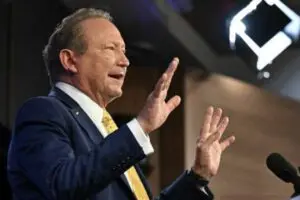Iron ore billionaire Andrew Forrest’s green hydrogen plans are expected to make a major step forward in early 2023 with its hydrogen electrolyser production facility due to begin manufacture. But mystery surrounds which technology it will be using.
The facility was hailed as the world’s biggest electrolyser manufacturing facility when first unveiled in 2021, with planned production of 2GW a year once at full capacity.
At the time, the partnership involved Plug Power, the listed US-based company that is one of the world’s leading hydrogen electrolyser companies. But Plug Power is strangely silent about what remains one of the biggest projects of its type in the world.
Overnight, Plug Power released its nine month results, with a bullish outlook for the coming two years – on revenue and the lowering of electrolyser costs, and the massive boost to the green hydrogen industry from Joe Biden’s Inflation Reduction Act.
There were also details of all the company’s electrolyser orders, its hydrogen supply deals with the likes of Amazon and Acciona, and the different electrolyser manufacturing projects it has in the US and elsewhere in the world.
But there was not a single mention of its agreement with Fortescue, nor even of Australia. It wasn’t mentioned either in the hour long conference call between Plug Power CEO and CFO with analysts.
It was the same in August when Plug Power released its half year results, where it made one brief mention of Fortescue, and didn’t discuss it further.
When RenewEconomy first enquired in August, when we found it passing strange there was no mention of the Australian deal, we were told that Plug Power continues to “collaborate” with the company on the Gladstone manufacturing facility.
On Wednesday, we got the same response from Fortescue Future Industries, the green energy arm that is leading Forrest’s push into the zero carbon world.
“Plug Power continues to be a collaborative partner and we are refining the commercial nature of our relationship as we grow and build capacity within FFI,” a spokesperson said by email.
“We remain on track to produce Australian made electrolysers from our Gladstone facility in 2023.”
FFI would comment no further, but it does beg the question about which technology FFI will be using when it begins production at Gladstone, at what new FFI CEO says will be the first of many electrolyser production facilities needed to meet Forrest’s ambitious green hydrogen plans.
It does have other options. Plug Power is by no means the only technology provider for electrolysers in the world, and FFI has invested in its own technologies, including the promising Sparc, which actually uses photocatalysis to produce hydrogen rather than electrolysis but appears to be at an early stage.
Late last year, Fortescue also announced it had designed and built its own electrolyser capable of producing renewable hydrogen. It said then that the process had yielded a number of new innovations in electrolyser design, which would form part of the company’s “electrolyser patent family”.
We’ll have to wait and see whether either Technology can be delivered at the Gladstone facility, the first of part of Forrest’s grand plan for a Green Manufacturing Hub. And it would be fascinating to know – if the “letter of intent” with Plug Power does not translate into a deal – exactly what went wrong, and why.










